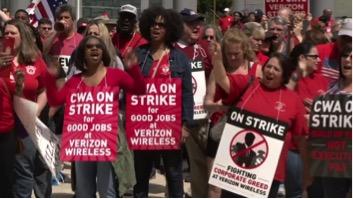Communication Breakdown: CWA, Verizon Go to War

Blood and Boots: A History of Union Violence in America, Part II
Over 35,000 Verizon workers are now in their fourth week of striking.
Union leadership at the Communication Workers of America (CWA) is upset about alleged job security, low wages and expensive healthcare for the company’s landline phone business and FiOS service workers.
Their “solution?” Skipping work while shouting loudly on the street. And other, darker measures.
The strike began April 13th, 2016. Within the first two weeks, Verizon reported 57 incidences of vandalism. Reports of intentional damage to Verizon equipment stretched across five states, including: disabled “terminal boxes and ‘severed’ fiber-optic cables.”
In a typical year, Verizon reports, “only six random acts of vandalism.” Could this recent, sudden surge be merely a coincidence?
The sabotage is not only threatening lines, but also lives: in Salisbury, MA one incident involved the destruction of a 911 emergency line.
And, this isn’t the first time we’ve seen this type of destruction during Verizon strikes.
In 2011, over 45,000 strikers swarmed the streets. Verizon also reported more than 143 incidents of vandalism, cutting service to thousands of residents, two nursing homes, a hospital and police station. The FBI was called to investigate.
At that time, the CWA emphasized they did not condone the violence. CNN Money reported that union spokeswoman Candice Johnson even accused Verizon of hiring “replacement workers to commit acts of sabotage on their own infrastructure to frame strikers and curry favor with the public.”
CNN Money went on to report that Johnson claimed that Verizon was guilty of picket-line violence, by “driving vehicles into picketing crowds, striking more than a dozen pickets.” Verizon's spokesperson Rich Young, rebutted that, “strikers were throwing themselves in front of vehicles.”
In one instance, a union member used his young daughter as a blockade in front of a moving Verizon truck while harassing the driver. (Note: After the video began circulating, the video’s owner removed the content from the original site.)
While those currently on strike are mostly servicers for the company’s landline infrastructure, CNN Money reports that, “Verizon continues to post record profit, but most of that is coming from its wireless business.” Meanwhile, the landline-business declined by nearly 2 percent in 2015.
In the face of the continued assaults on their infrastructure, on April 27, Verizon reportedly offered, “a 7.5 percent wage increase over the term of the contract, continued pension benefits up to a 30-year cap and a pledge to maintain healthcare coverage.”
The union did not accept. Marc Reed, Verizon’s chief administrative officer replied to the decline:
“It’s unfortunate that union leaders have denounced our proposal. We’ve given the unions a great offer. Their reaction to our offer does nothing to benefit our employees who are not where they should be – back at work and serving our customers.”
Penn Live reported that, “healthcare benefits for roughly 110,000 union members and their dependents" expired later that week, thanks to the union and its intransigence.
It’s a classic and unfortunate communication breakdown. How ironic that communication-workers broke it down.
Communication Breakdown? Click the picture above!






